Wingshooting Under South African Skies
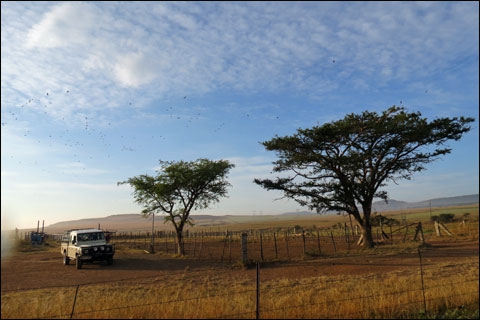
The thrill of bird hunting in South Africa struck on our first morning out when, driving on rutted roads to the fields, we spotted zebras, wildebeest, reedbucks, eland and jackals. And as it would play out a jackal had grabbed an Egyptian goose I had downed even before our German Wiredhaired could retrieve it.
Although plains game hunters might let their ruminations run wild in pursuit of the game birds there, veteran outfitter Todd Lutman has made it his personal mission to introduce American hunters to the abundance of game-bird species in South Africa.
For Mr. Lutman, the ideal bird hunter in South Africa is flexible, because if there’s one word to describe the essential tactics it’s “opportunistic.”

The author bird hunting in the tall grasses of South Africa.
Here and abroad you’ll typically embark on a hunt for a specific type of bird – and maybe find a second species along the way. In South Africa’s Zululand, it’s crazy with the different birds you encounter. Just glass the fields and sky for the next possibility. Fortunately, Mr. Lutman’s vintage Land Rover Defender was unstoppable through the grasslands, wetlands and highlands of nearby farms.
The region of Kwazulu-Natal, where we hunted, held the largest percentage of agricultural households in South Africa, according to the organization Statistics South Africa. Kwazulu-Natal ranked second in beef cattle production regions in the country as reported by the South African Society for Animal Science. Since 2001, South Africa’s beef consumption has increased approximately 25 percent – a boon for both farmers and game-bird hunters who seek out the birds in crops that sustain the country’s growing cattle population.
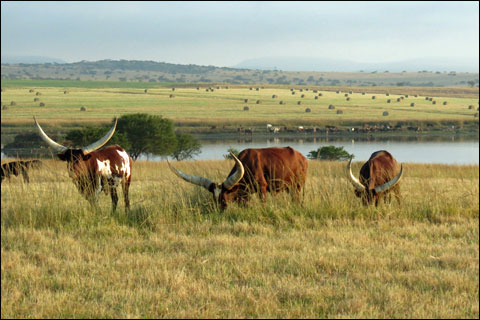
Long-horn Ankole cattle from Uganda on one of the cattle ranches where we hunted birds.
Greta Geldenhuys, a Ph.D. in the Faculty of AgriSciences at South Africa’s Stellenbosch University, wrote in 2014 “In Southern Africa, the hunting of wildfowl species has increased considerably in the past few years. Crop farmers incur major financial losses due to the feeding activities of Egyptian geese (Alopochen aegyptiacus); consequently a large number of geese are hunted in an attempt to reduce the damage caused.”
A separate report by Dr. Geldenhuys cited 44 game-bird species in South Africa and of them the most prevalent were Egyptian geese and helmeted guineafowl – the birds we spent the most time hunting on the farms.
We never left in the morning without packing at least four different size shotshell loads. On any single day we randomly hunted quail, rock pigeons, partridge, guineafowl, ducks, geese, doves and francolin in a variety of sub-species. Take a shot at ducks, they scatter and we’re back in the Defender for pigeons and after that francolin – all on the same lush farmland.
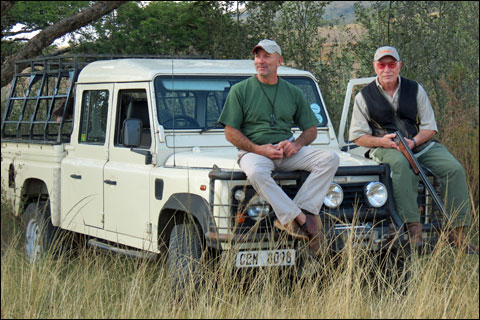
Outfitter Todd Lutman (left) with the author on the vintage Land Rover Defender.
The variety can reach an extreme. One afternoon we had been stalking cagey guineafowl when the farm manager, who was a friend of Mr. Lutman’s, stopped by in a pick-up truck and asked us, as a personal favor, to hunt the wild hogs he saw that morning. We could have with the #3s packed for geese that day. We opted out of the hogs, since squadrons of Egyptian and bigger spur-winged geese flew overhead on their way to pick clean the fields of soya, sorghum, maize and oats.
American farmers may monetize pheasant hunts, but their South African counterparts want all birds off their property. Wild and voracious, the birds simply eat away at the bottom line.
To illustrate the point, as Mr. Lutman drove the Land Rover Defender along the periphery to raise geese from the fields, the farmer hopped on his dirt bike and kicked up a dust plume to drive hundreds of feeding geese toward my impromptu blind where I squatted in a missed sliver of crops in the sprawl of harvest debris. If I had been with two or three other hunters shooting semi-autos, it would been an incredible bounty compared with me, alone and the over/under at my disposable.

The 12-gauge Sabatti originally owned by Todd Lutman’s father had seen action in Africa.
The 12-gauge Sabatti over/under, purchased by Mr. Lutman’s father in 1979, was my first choice from his inventory simply because it had a lovely patina and connections to Botswana and Zimbabwe where Mr. Lutman had lived and guided dangerous game for 26 years. With the Italian Sabattis, as well as F.A.I.R. shotguns, reappearing this year in the U.S. through the Italian Firearms Group of Amarillo, Texas, that old Sabatti helped transport me back in time and capture the frontier romance of South African wingshooting, opening the consideration for purchasing a new one back home.
If you’re wondering why I didn’t bring my own shotgun to South Africa, there were two reasons: an overnight stay in Dubai (the Emirates Airlines hub for our connecting flight to Durban, South Africa) that would have required too much red tape, in addition to a Big 5 photo safari to South Africa’s Hluhluwe-Imfolozi game reserve where firearms are also prohibited (we were flying directly from the reserve to Cape Town for wine tasting in the nearby Stellenbosch district).
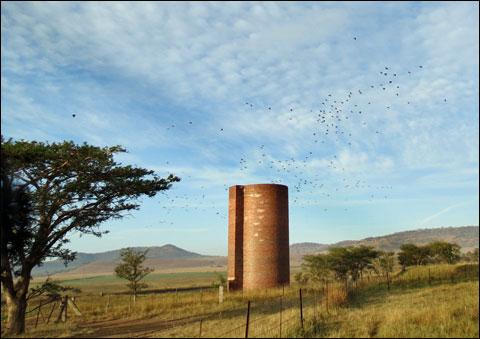
Ducks scattered around a brick silo after a couple of shots. The author had downed two birds there in a pond, but before the dog could retrieve them catfish dragged the ducks under.
That said, traveling with a hunting firearm to South Africa is quite easy. We had flown into Durban’s King Shaka International Airport where the offices to check and claim your gun were clearly marked. Simply check with Mr. Lutman in advance for information.
We had arrived in South Africa early May at the beginning of prime game-bird hunting – missing some of the bigger numbers you’d expect from June through August. Ultimately, you hunt South Africa for the challenging variety of game birds and volume is a bonus – for example the hot-barrel pigeon shooting where millions of the pests roost during the sunflower harvests of March and April (no bag limits).
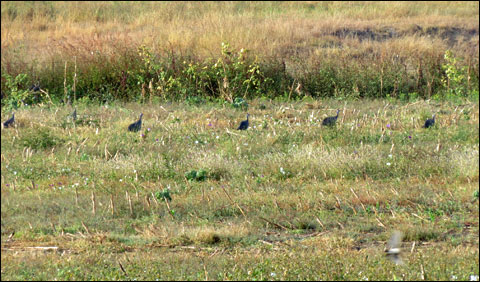
This is about as close we could get to the fast-running guineafowl. Bring your full choke to South Africa.
For those us accustomed to fields stocked and replenished with pen-raised game birds, South Africa’s wild population is nirvana. The birds are quick, wily and elusive – sometimes running so fast out of range they never bothered to flush and when they did you’d need tight chokes that reached out there. That’s when I appreciated the old Sabatti for making long shots with 28-inch barrels choked the equivalent of modified and improved modified.
Bird hunting in South Africa is like turning back the clock to a bygone era. Several of the farms we hunted were cradled in savannahs populated by the iconic acacia trees and plains game of Zululand that produced landscapes impervious to progress. Low cloud formations appeared primal and ancient with contrasting billowy brilliance and shaded underbellies casting dramatic shadows on the hillsides. Farm workers, dressed in bright clothes, would herd small groups of cattle on foot to watering holes or lead a flock of sheep. Driving between farms, we’d encounter cattle, sheep and baboons on the roadside. The locals seemed to be in perpetual migration on foot along the rough shoulders. Women still carried bundles on their heads. And virtuoso sunsets the colors of erupting volcanoes foreshowed our return to Mr. Lutman’s rustic farmhouse for a traditional South African fireside dinner accompanied by spectacular regional wines.
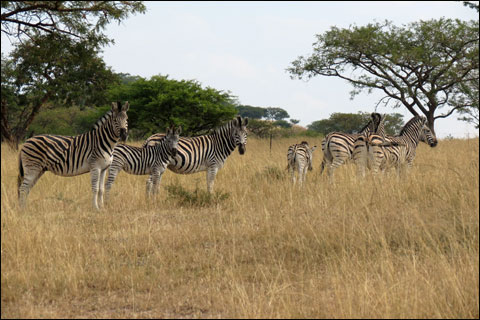
Zebra on a farm where we also hunted birds.
One particular farm we hunted spread to the foothills of the Northern Drakensberg Mountains, just below the historic Spion Kop Battlefield of January 24, 1900 − perhaps the bloodiest battle in the Anglo-Boer War.
During our afternoon break the day before, Mr. Lutman had arranged for us to tour that mountaintop with noted South African historian, Raymond Heron. He had called the Anglo-Boer War “the last of the gentlemen’s war” as truces were called at Spion Kop to bury the dead and the 17-mile long column of British troops included a wagon of Champagne for the commanding officer.

South African historian Raymond Heron atop Spion Kop.
We hiked toward the summit on a rocky trail with Mr. Heron narrating the course of events that would lead to a particular landmark notoriously called the “Acre of Massacre.” British regiments had attempted to take the hill from the entrenched tiny outpost of Boer snipers and their Zulu laborers. Misguided intelligence of the hill’s topography, rigid chains of command, arrogance, sudden weather changes and bright uniforms of red and blue led to a slaughter of the larger British forces. After the smoke cleared, history had deemed that a British soldier named Winston Churchill and stretcher bearer Mahatma Gandhi would survive to leave their own indelible marks on modern times.
Mr. Lutman goes to great lengths to ensure a historic sensibility to his hunts. He has exclusive access to approximately 50,000 acres so that no other hunters are around you. He explained that it has taken him nearly five years to gain the farmers’ trust for those precious hunting rights. If he shoots a covey in one location, he won’t return there for another year to preserve the bird’s wild instincts and population.

A cabin on Todd Lutman’s new bird-hunting concession in the Drakensberg mountains.
Right before our arrival, he had secured the bird-hunting concession to a mountaintop property in the Drakensbergs that he showed us after a morning hunt. We broke up the one-hour drive with a stop for gourmet pizza prepared in a wood-fired brick oven. Back in the Land Rover Defender, he started the climb on a twisting road to the summit where his friend owned a roadhouse with room accommodations on the several thousand acres that would be ready for us to hunt in 2016.
The blustery mountain meadows overlooking a stocked lake opened to a virtually unlimited vista of Zululand. Mr. Lutman showed us the two charming pond-side cottages on the property where hunters will stay. Afterwards, we couldn’t resist the scones with jam and clotted cream, and some Earl Grey tea, on the roadhouse porch.

Frankie with three of the four Egyptian geese taken during an afternoon hunt. The fourth goose had been grabbed by a jackal while we hunted from the lake-front makeshift blind.
That was the final day bird hunting with Mr. Lutman, but our adventure wasn’t finished yet. At sunrise the next morning, we packed the Land Rover Defender and drove three-and-half hours to South Africa’s Hluhluwe-Imfolozi Game Reserve to see the Big 5. It was here that Mr. Lutman started in his guiding career decades ago, leading us on a three-day personalized tour of the 250,000 acre park from his truck.
We stayed at the Reserve’s Hilltop Camp – a compound of luxury cottages with different sleeping accommodations. The on-site restaurant and bar featured an outdoor patio with incredible vistas where we would see nyala, eland, kudu, impala and baboons graze while enjoying our lunch.

This bull elephant suddenly appeared during our tour at the Hluhluwe-Imfolozi Game Reserve.
Over the course of our tour, we experienced close encounters with elephants, giraffes, rhino, baboons and cape buffalo. During a nighttime tour led by the reserve, we also saw lions feeding on a cape buffalo carcass. Upon our return that evening, we caught up again with Mr. Lutman for a lovely buffet in the dining room.
After our third day, Mr. Lutman drove us back to Durban for a flight to Cape Town and a subsequent tour of the extraordinary wine region of Stellenbosch.
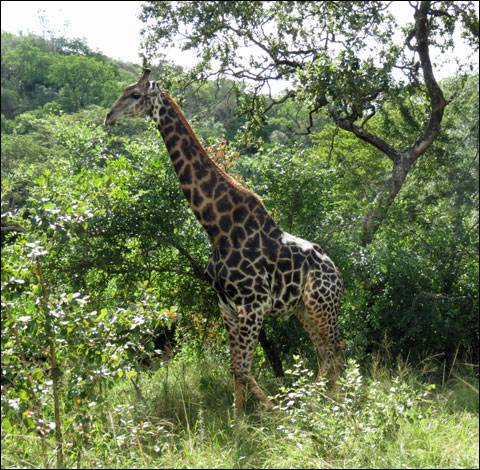
Up close and personal with a giraffe at the Hluhluwe-Imfolozi Game Reserve.
When I return in 2016 to bird hunt with Mr. Lutman there are few things I’d do differently. First, I’d bring along some hunting companions. The real problem hunting solo with so many birds is that you may get two shots at most before the birds have dispersed out of range. More hunters certainly would have exploited the number of birds available. I would also bring a 12-gauge semi-auto with a larger shell capacity than the over/under.
Personally, I agree with Mr. Lutman that South Africa’s game-bird potential is enormous, set in an exotic country with magnificent scenery and an amazing variety of available species. South Africa offers the potential to combine wingshooting with plains-game hunts, fishing, photo safaris and wine tasting. Yes, you can say it’s sort of like Argentina – only wilder.
Irwin Greenstein is the Publisher of Shotgun Life. You can reach him at contact@shotgunlife.com.
Useful resources:
The web site for Todd Lutman’s Safari Bound Southern Africa Outfitters
Italian Firearms Group web site
The Hluhluwe-Imfolozi Game Reserve web site
Raymond Heron’s Spionkop Lodge web site

Irwin Greenstein is Publisher of Shotgun Life. Please send your comments to letters@shotgunlife.com.


Comments